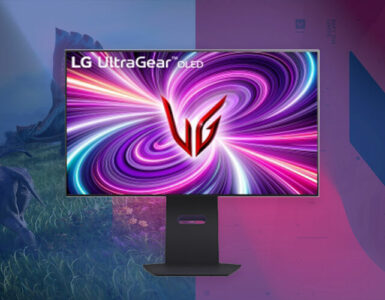Technically, curved displays are nothing new. They’ve often been unveiled at tech shows over the past several years, by one electronics giant or another. Even so, they’re usually regarded as gimmicks, nothing more than fancy prototypes built to showcase the manufacturer’s technological prowess; as proof of concept for publicity’s sake, and not true consumer products. Prior to this year, you’d be extremely hard-pressed to find someone who actually owned one.
 We’ve all heard numerous buzzwords and acronyms being thrown around in the TV industry for quite some time now: High definition, OLED, 3D, Smart TVs, Ultra High Definition, 4K… the list goes on and on.
We’ve all heard numerous buzzwords and acronyms being thrown around in the TV industry for quite some time now: High definition, OLED, 3D, Smart TVs, Ultra High Definition, 4K… the list goes on and on.
Technology pertaining to television sets seems to have advanced more in the last decade than in the preceding half-century combined; we’ve made the leap from bulky CRTs to slim, flat screens in a mere handful of years. And now, it seems like we are yet again on the cusp of something different.
Considering how fiercely competitive the consumer electronics industry can be, this is hardly surprising; our insatiable appetite for new and improved experiences when it comes to audio-visual entertainment only serves as motivation for manufacturers to push the envelope ever higher.
This year, there has been a strong marketing push for curved displays on the part of all the major TV manufacturers. Many of the biggest names in consumer electronics displayed curved screens at CES back in January, and the message is clear: Curved TVs are now a thing, and they are going to find their way into your living room one way or another.
Yet, my skepticism remained; after all, the transition from convex CRT screens to flat displays was perceived as natural progression. Would the general public be so quick to embrace curved television screens once again? (Yeah yeah, I know, they’re curved differently this time.)
After attending LG‘s Launch Event for their 2014 TV line-up, I’m a little more inclined to believe it could happen.

Held at a swanky uptown restaurant in the heart of Singapore (which serves some amazing food, by the way), it was clear that LG were sparing no expense in their efforts to convince the masses, or at least the gathered journalists, that we have entered a new generation of audio/visual splendor with their line-up of TVs for 2014.
Ms. Reece Teo, Sales Director for LG’s Consumer Electronics in Singapore, gave a brief opening address, but the formalities were soon dispensed with and we moved on to the real meat of the show.
 Headlining the event was of course, LG’s next-generation Curved OLED TV, the 55EA970T. As the pioneer of OLED TV technology, LG has clearly incorporated their expertise in this field into their latest offering.
Headlining the event was of course, LG’s next-generation Curved OLED TV, the 55EA970T. As the pioneer of OLED TV technology, LG has clearly incorporated their expertise in this field into their latest offering.
With their TVs already boasting an infinite contrast ratio and excellent color accuracy, LG promises that the curved screen will only serve to further enhance the viewer’s experience, delivering the optimal image quality regardless of ambient light or viewing angle.
Upon first glance, I was struck by just how thin the 55EA970T was. My very first flat TV was about 2 inches thick, and even the current OLED TV that I have in my living room (incidentally, also an LG model) is about a centimeter in thickness. The 55EA970T , however, featured a screen that measured no more than 3-4 millimeters in thickness; not quite “paper slim” as claimed, but close enough to make an impression.
It was a little surprising to me that LG were able to refine this technology so quickly; after all, flat LCD and plasma screens did take several years to reach such a level of miniaturization. Even if you chalk it up to LG’s cumulative expertise and experience when it comes to streamlining their displays, they’ve certainly trimmed off a substantial bit of fat here. Quite an impressive feat of engineering, if you ask me.

On a flat screen, the edges of the display are further from the viewer’s eyes than the center, and this distorts the viewer’s perception of the image; the larger the screen, the more apparent the distortion, resulting in diminished image quality, eye strain, and various other issues. Or at least, this is what television manufacturers want you to believe.
In theory, this distortion could be eliminated by ensuring that the image is equidistant from our eyes across the width of the screen; this is achieved by essentially mimicking the natural curve of the human skull and taking the placement of our eyes into consideration. This is pretty much the entire concept behind the development of TVs with curved displays.
 You can probably tell that I am a little skeptical about the whole idea, given that there are so many factors to consider. For one, everybody’s facial structure differs, so what works for one person may not work for another.
You can probably tell that I am a little skeptical about the whole idea, given that there are so many factors to consider. For one, everybody’s facial structure differs, so what works for one person may not work for another.
Viewing distance is also another wildcard, and I wondered just how many other variables the R&D team had to consider before they decided on a optimal curvature.
Given my limited exposure to the 55EA970T at the event, I can’t really give a definitive verdict on the effectiveness of this curved solution. However, I do get the distinct impression that LG have nailed a good compromise, given the multitude of variables they’ve had to work with. During the course of an hour or so, I made it a point to observe the screens from several spots in the room: up close, far away, straight-on, from an awkward angle, etc.
I’m pretty pleased to report that the 55EA970T held up really well under my (rather limited) scrutiny. The images on the curved screen retained a consistent level of clarity regardless of viewing angle and distance, though I am uncertain as to whether or not it would hold up under extended usage. A more accurate assessment would have required additional time, which unfortunately I did not have.
Audiophiles were not left wanting either. It was announced at the event that LG has collaborated with audio equipment giants Harman/Kardon to develop the ULTRA Surround sound system featured in all next-generation LG TVs.
 With the aim of delivering a level of viewer immersion akin to the cinema experience, the ULTRA Surround system seems to be the perfect complement to the high picture quality that LG already offers.
With the aim of delivering a level of viewer immersion akin to the cinema experience, the ULTRA Surround system seems to be the perfect complement to the high picture quality that LG already offers.
Despite what I said earlier in the article about the advancement of TV technology in recent times, the auditory component has always been playing catch-up to the visuals. Audiophiles would use dedicated sound systems to get around this problem, but that can be a costly or impractical option for the rest of us.
With the ULTRA Surround system, it seems like LG and Harmon/Kardon have finally leveled the playing field by delivering unprecedented audio quality alongside the pretty moving images. I’ve always found TV speakers to be woefully inadequate for movie or gaming purposes, so this collaboration opens up a world of exciting possibilities. I really hope to see see more of such similar collaborations in the near future.
Not satisfied with merely offering us improvements in terms of sight and sound, we were also introduced to the latest operating system for LG’s Smart TVs. Acquired from Hewlett-Packard last year and extensively re-worked for the Smart TV platform, webOS has been integrated into all next-generation Smart TVs from LG’s 2014 line-up.

Mr Colin Zhao, Global Director of Product Management for LG’s Silicon Valley Lab, was on hand to perform a live demonstration of webOS for the gathered press. As the driving force behind the revival of webOS, Mr Zhao was instrumental in bringing the mobile operating system to LG’s Smart TVs.
According to Mr Zhao, simplification and user-friendliness was the key design element behind webOS, and he took us on a tour of the system starting from the raw basics. Upon starting up a webOS-enabled Smart TV for the first time, a cutesy animated character named BeanBird greets users and walks them through the initial setup process.
 This mode of interaction seems very prevalent throughout webOS, with a much-reduced emphasis on traditional menus in favor of animated, friendly animations. While this may not be a big deal to power-users, I can see how this approach would put non-tech-savvy users at ease with the system.
This mode of interaction seems very prevalent throughout webOS, with a much-reduced emphasis on traditional menus in favor of animated, friendly animations. While this may not be a big deal to power-users, I can see how this approach would put non-tech-savvy users at ease with the system.
Paired with the LG Magic Remote, users are presented with a wide range of control options for their Smart TV. You can pretty much use the Magic Remote like a mouse, or more accurately, like a Nintendo Wii Remote to manipulate buttons and menus on the screen.
It’s immediately obvious to me that the webOS team have gotten some inspiration from video game console interfaces, and this is most apparent in the look and feel of the Launcher, which is a left-to-right scrollable menu that runs along the lower portion of the screen. The pastel colors and large tabbed buttons reminded me of the old Xbox360 “blade” interface, before it got all jazzed up to look like Windows 8.
 In my personal experience, multi-tasking has always been a sticking point with Smart TVs. The Launcher is an elegant solution to this problem; alternating between different tasks or video streams is a breeze, and the platform is fully capable of keeping apps running in the background for quick, seamless switching.
In my personal experience, multi-tasking has always been a sticking point with Smart TVs. The Launcher is an elegant solution to this problem; alternating between different tasks or video streams is a breeze, and the platform is fully capable of keeping apps running in the background for quick, seamless switching.
All in all, I came away from the event pretty impressed with LG’s 2014 TV line-up. While it still remains to be seen if all these innovations will have staying power with general consumers, I’m pleased to note that big players in the electronics business like LG are continuing to push the envelope when it comes to offering new experiences with their products. I think I might be in the market for a new TV pretty soon!
Brian loves video games, gadgets, and comic books – in other words, all things geeky. Obsessed with lifting things up and putting them down repeatedly, he also loves ice cream, putting things together, and the occasional good book.












